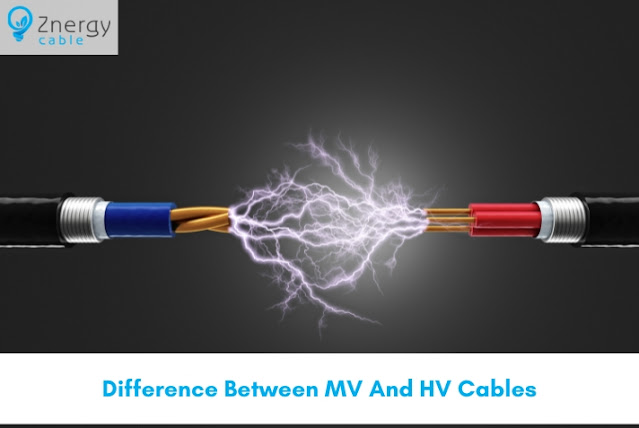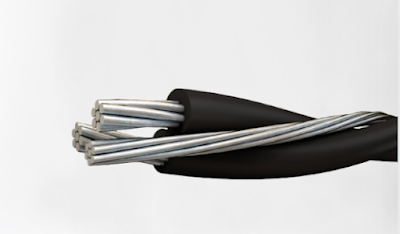Difference between MV and HV cables
Medium Voltage (MV) cables and High Voltage (HV) cables are two unique actors in the electrical transmission arena. MV cables transport electricity in the moderate voltage range of 1 kV to 69 kV, allowing power distribution from substations to local networks. Their design incorporates conductors, insulation, and sheathing for efficiency and safety in a variety of applications, including residential and commercial power delivery.
High Voltage cables, on the other hand, run at much greater voltages, ranging from 69 kV to over 1000 kV. HV cables are the backbone of long-distance power transmission, linking power production sources to substations and even spanning intercontinental gaps. Their sophisticated design incorporates modern insulation technologies such as XLPE, assuring their ability to tolerate massive electrical strains.
MV cables excel in localised power distribution, but HV cables overcome the obstacles of transmitting electricity over long distances. These cable kinds reflect many threads in the electrical tapestry, each with its own purpose in maintaining the smooth and dependable distribution of power to fulfil the changing needs of modern civilisation.
Medium Voltage cable and High Voltage (HV) cables are two separate pillars in the complex world of electrical transmission and distribution, each with its own set of features and applications. We'll look at the distinctions between various cable kinds while also looking at the cable production scene in Australia.
Medium Voltage(MV) Cables:
MV cables, also known as Medium Voltage Power Cables, serve an important role in transferring energy at intermediate voltage levels ranging from 1 kV (1000 volts) to 69 kV. These cables are critical in transporting power from substations to local distribution networks, ensuring that households, companies, and industries have a continuous and stable supply of electricity.
Key Characteristics of MV cables:
1.Voltage Range:
MV cables, as the name implies, operate at medium voltages. As a result, they are well suited to applications needing modest power capacity, such as urban and rural power distribution.
2.Construction:
MV cables include numerous layers for efficient and safe functioning. They are constructed up of copper or aluminium conductors that are surrounded by layers of insulation and protective sheathing. This design provides both electrical integrity and mechanical longevity.
3.Application:
MV cables are used in a variety of purposes, including powering residential areas, business buildings, hospitals, and factories. They are also used in renewable energy initiatives and infrastructure construction.
High voltage(HV) cables:
High Voltage cables, also known as Extra High Voltage (EHV) cables, are designed to deliver electricity at substantially greater voltage levels than MV cables. These cables are critical for carrying electricity over longer distances with low energy loss, linking power production sources to important substations.
Key characteristics of HV cables:
1.Voltage range:
HV cables run at substantially higher voltage levels, often beginning at 69 kV and increasing to ultra-high voltages of 1000 kV or more. HV cables are useful for long-distance power transmission and linking significant power nodes due to their increased voltage capacity.
2.Complex design:
HV cables are designed with even more complex insulation methods, frequently utilising technologies like as XLPE (Cross-Linked Polyethylene) insulation. This allows them to endure the increased electrical strains that occur with higher voltage ratings.
3.Application:
HV cables are essential for joining multiple power grids, transporting electricity from power plants to substations, and even underwater power transmission. Their capacity to travel greater distances with low energy loss makes them vital for effective energy distribution.
Australian cable Landscape:
Australia has a thriving cable manufacturing business that produces a diversified range of cables to meet a variety of demands. Both MV and HV cables are made in the nation in accordance with severe quality requirements and regulations.
Both Medium Voltage (MV) and High Voltage (HV) cables play critical roles in the evolving landscape of electrical transmission. While MV cables provide effective power distribution in local networks, HV cables overcome the difficulties of long-distance power transmission. The Australian cable anufacturing business, which includes firms such as Nexans Australia and Prysmian Group, contributes considerably to the nation's energy infrastructure by creating high-quality cables to suit the demands of both MV and HV applications. These cable types will continue to be important pillars of the current power landscape as technology progresses and the requirement for efficient energy transmission grows.
HV and MV Cable Manufacturers
Znergy Cable is a HV cable manufacturing company in Australia on the cutting edge of the energy industry. With over a decade of experience, Znergy Cable has built a formidable reputation for creating high-quality HV cables that provide reliable and efficient power transfer over extended distances.
The company's cutting-edge manufacturing facilities use advanced technologies and a highly skilled personnel to produce innovative solutions customised to the different needs of utility companies, industrial sectors, and renewable energy projects.
Znergy Cable's commitment to sustainability and environmentally friendly practises strengthens its position as an industry electrical cable manufacturer leader, driving the global shift to a greener and more sustainable future.




Comments
Post a Comment